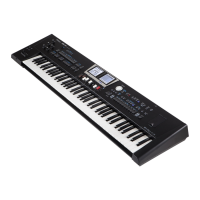Before You Start Using BK-9
22
The BK-9 MIDI THRU socket exactly duplicates whatever data is being
received at the BK-9 MIDI IN socket. It is used to connect to the MIDI IN of
another device.
MIDI channels
MIDI provides sixteen channels, numbered 1~16. Even if two MIDI devices
are connected, you won’t be able to select or play sounds on the other
device unless both devices are set to the same MIDI channel. For more
details see “MIDI” (p. 151).
The BK-9 is capable to transmit and receive on all channels, 1~16.
NOTE
Before making connections with other devices, you must turn
down the volume of all devices and turn o the power to avoid
malfunctions or speaker damage.
Connecting Optional Pedals
You can connect optional pedal switches and expression pedals to
control many function of BK-9.
Connect to the
PEDAL HOLD jack
an optional Roland
DP-series or BOSS
FS-5U pedal
switch to hold the
notes of the real-
time parts.
Connect to the
PEDAL EXPRESSION
jack an optional
expression pedal
(Roland EV-5) to
control the volume.
Connect to the PEDAL CONTROL jack
an optional Roland DP-series, an optional
foot switch (BOSS FS-5U) or an optional
expression pedal (Roland EV-5) to control
dierent functions and eects.
NOTE
If you connect a Pedal Switch (e.g. DP2),
to set the function that you want to
assign see “If You Connect a Pedal Switch
(Not Continuous)” (p. 145).
If you connect a Continuos Pedal (e.g.
DP-10) or Expression Pedal, see “If You
Connect a Pedal Control (Continuous)”
(p. 145) to set the function that you
want to assign.
Connect to the
PEDAL FC-7 socket
an optional Roland
FC-7 pedal to control
dierent functions. For
more details see “Pedal
Controller FC-7” (p. 146).
NOTE
Use only the specied expression pedal (Roland EV-series, sold
separately) or pedal switch (Roland DP-series, BOSS FS-5U). By
connecting any other expression pedal or pedal switch, you risk
causing malfunction and/or damage the unit.
Connecting an Optional Vocal
Performer (VE-5, VE-20)
1. Turn the BK-9 [VOLUME] knob all the way to the left to
minimize the volume.
2. Connect your microphone to VE-5’s MIC IN jack , and
connect VE-5’s XLR OUT jack to BK-9’s MIC IN jack.
If you use VE-20, connect your microphone to VE-20’s INPUT jack,
and connect VE-20’s OUTPUT L/MONO jack to BK-9’s MIC IN jack.
NOTE
• Please set the Phantom switch on the rear
of BK-9 to “OFF”.
• Before you make connections, make sure
that the Vocal Performer is turned o.
For more details refer to VE-5 or VE-20 owner’s manual.
Connecting a MIDI Device
The BK-9 can transmit and receive performance data when
connected to an external MIDI device, which enables the two
devices to control each other’s performance.
Connection example
If you use a MIDI cable (commercially available) to connect this
unit’s MIDI OUT connector to the MIDI IN connector of your
external MIDI sound module, you’ll be able to produce sound on
the external MIDI sound module by playing this unit’s keyboard. As
necessary, set the external MIDI sound module’s receive channel to
match this unit’s MIDI transmit channel.
What is MIDI?
MIDI, short for “Musical Instrument Digital Interface,” was developed
as a universal standard for the exchange of performance data
among electronic musical instruments and computers.
The BK-9 is equipped with MIDI connectors to let it exchange
performance data with external devices. These connectors can be
used to connect the unit to an external device for even greater
versatility.
THRUI
UTOUT
IN
BK-9
MIDI sound module/
sequencer
Using the BK-9 to play your MIDI sound module
Playing the BK-9’s sounds from your MIDI sequencer

